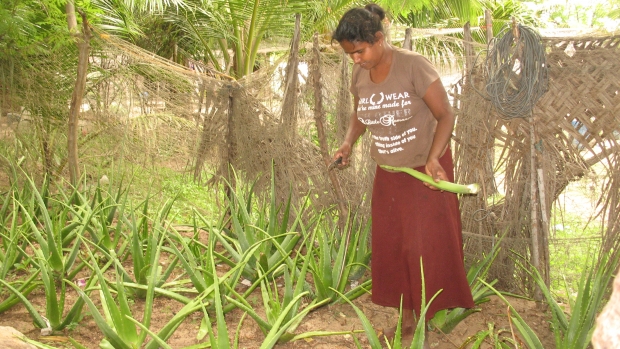Grants :: Small Grant Facilities :: Aloe vera cultivation in Kalpitiya
Aloe vera cultivation in Kalpitiya

Harvesting aloe vera, Sri Lanka © KEkaratne, 2010
Objectives
- Enhance the income of fisher families through product innovation, value-addition and market access;
- Increase the capacity of women and youth to use their time effectively on income generation;
- Promote the medicinal value of Aloe vera plants for the treatment of illnesses;
- Increase the socio-economic standard of fisher families; and
- Discourage communities from engaging in destructive activities that impact the Lagoon and reefs.
Background
The majority of people living in the Puttalam area are dependent on the already over-stretched fisheries resources of the Puttalam Lagoon and reefs near the coastal areas. Currently, there are about 165,000 people directly or indirectly dependent on the Puttalam Lagoon, including nearly 15,000 active fishers, of which 5,938 fish directly in the Lagoon. It has been reported that lagoon fisheries are already one and a half times the amount that should be harvested sustainably.
In addition, many communities in the Kalpitiya peninsula of the Puttalam District are also needy and poorly educated. Overlaying these constraints is weak coastal management in the area, with the consequence that their income-generating capacities are severely limited. Therefore, initiatives that generate alternative livelihoods to ease pressure on the Lagoon and to supplement the fisher families’ income are needed in the area urgently.
Interventions:
- Twenty new fisherwomen were identified through the four fisheries co-operative societies and in-situ training programmes were conducted on cultivation and land preparation. Each family was also given new plants and organic manure.
- Resource management and financial training were also given.
- A buy-back system and proper market linkages were established to institutionalize Aloe vera cultivators.
- A processing unit was established and a market value added to Aloe vera products made from this unit.
- The programme has been publicized.
Target beneficiaries
20 women from fisher families.
Outputs
- Aloe vera leaves are purchased by the cosmetics industry, while the excess is turned into an Aloe vera drink and sold commercially in a mobile selling cart. Guidance for hygiene during preparation has been provided by the Public Health Inspector and business approval was obtained from the Kalpitiya Pradeshiya Sabha.
- Six thousand leaflets have been printed in the vernacular and are being distributed by the mobile cart seller. Another 6,000 brochures have been printed in English to target foreign tourists visiting Kalpitiya.
Accomplishments and challenges
- The project has had a social impact by enhancing the self-confidence, social status and financial capabilities of fisherwomen.
- Cultivation of Aloe vera is reported to improve the quality of the soil. In addition, the project has had a positive impact on the environment by reducing dependency on fisheries resources.
- Finally, the project has had an economic impact by creating a stable income for fishing families.
Contributions to cross-cutting themes
Direct beneficiaries are women, but they are assisted by male members of their families.
Lessons Learned
The project has shown how people have begun to appreciate a new health supplement, and are being increasingly encouraged to enter this sub-stream activity.
There is a low harvest of Aloe vera during the dry season, and a higher harvest during wet weather. Conversely, the demand for this beverage was high during the dry season and low during the wet season.
Project Facts
Country
Location
Kalpitiya, Puttalam
Topic
Duration
1st May 2011 to 30th Apr 2012
MFF Grant Amount
LKR 538,000.00